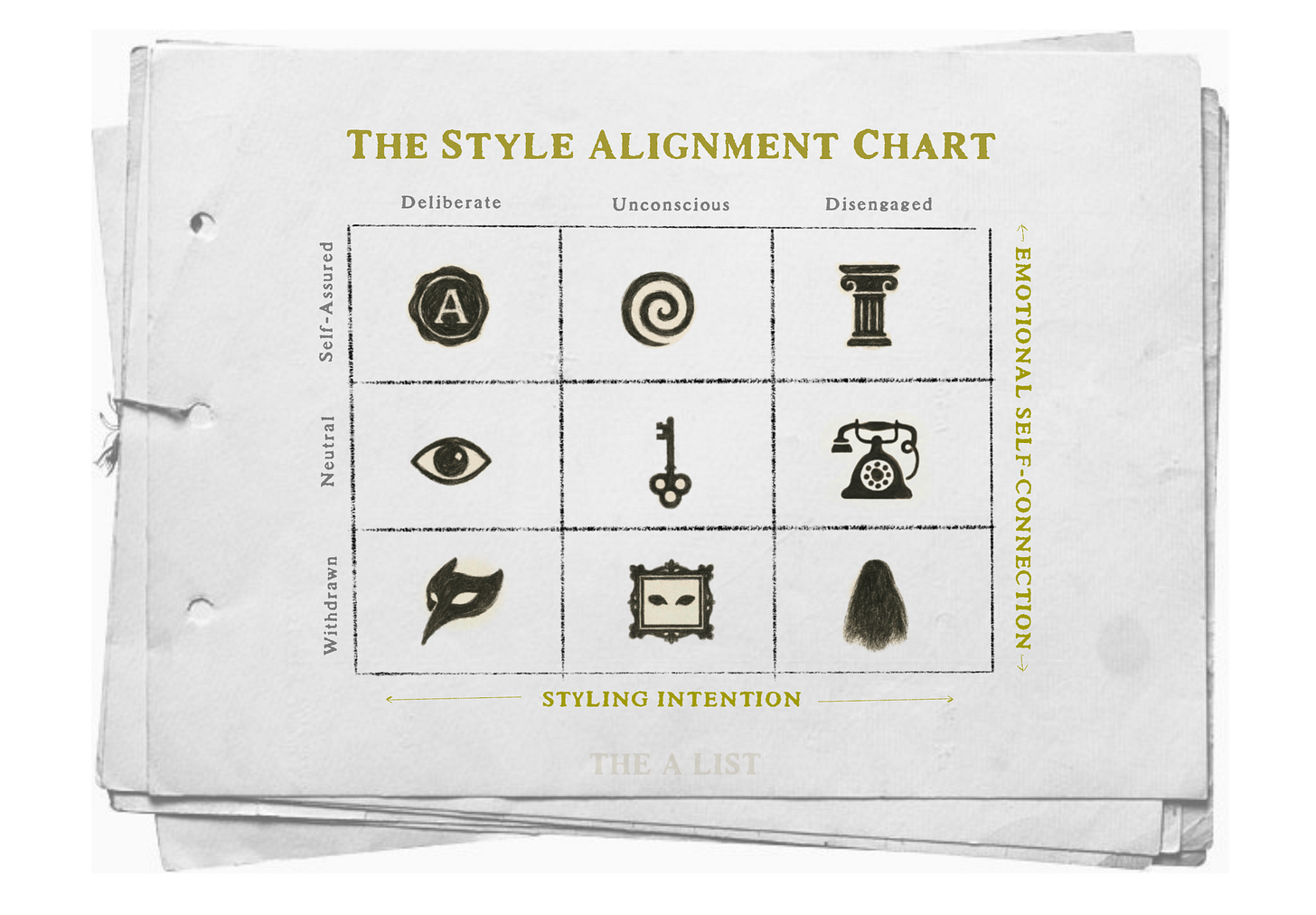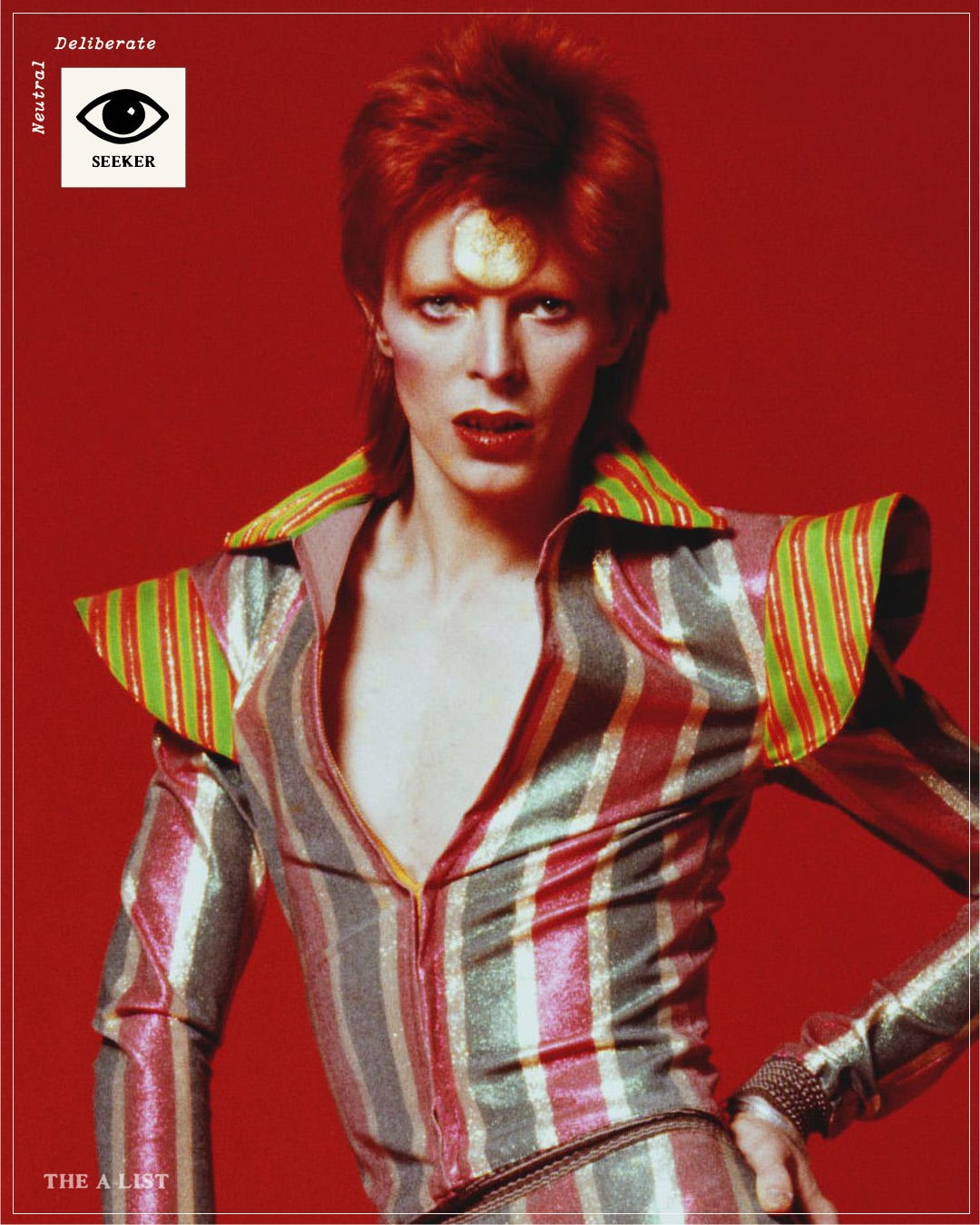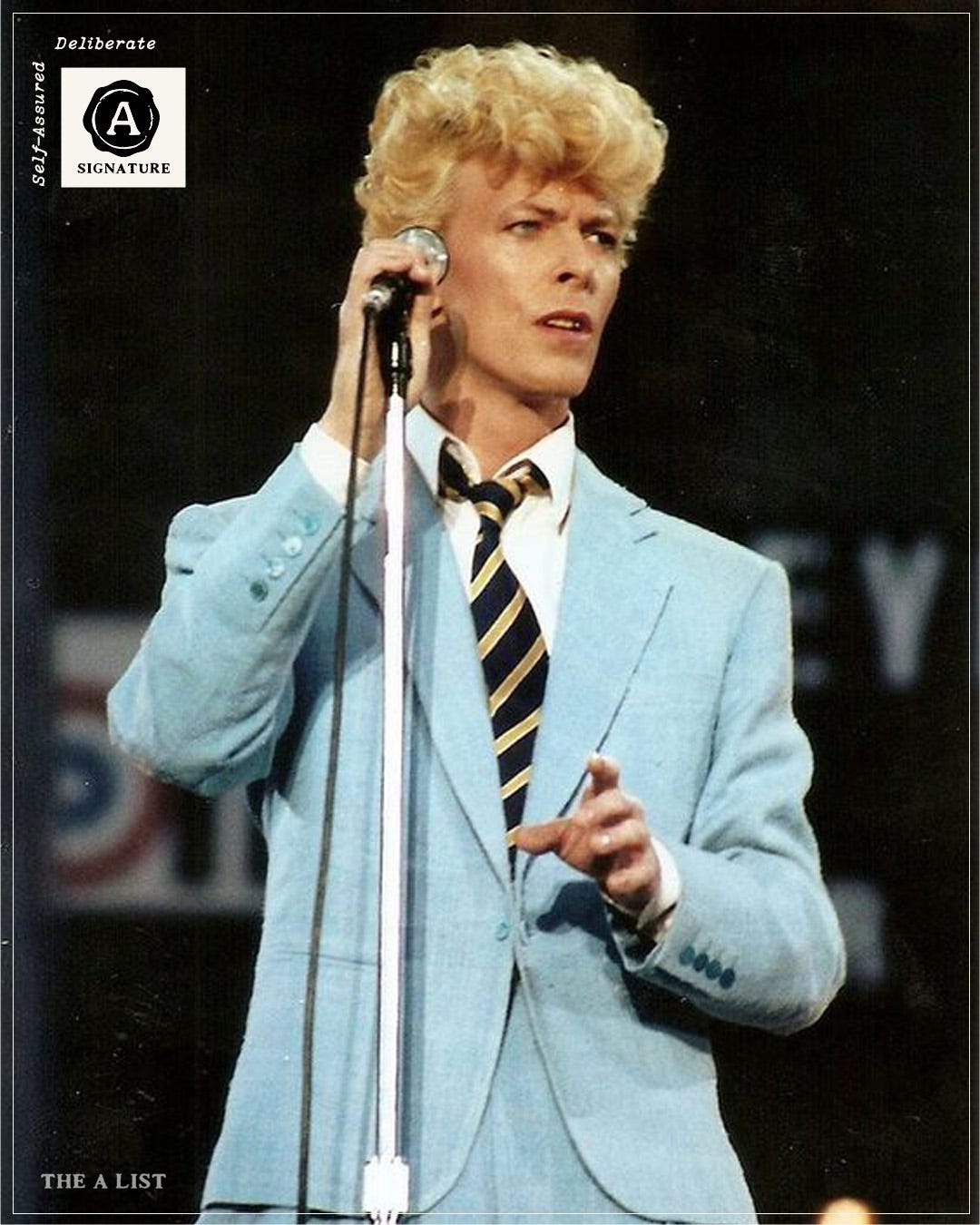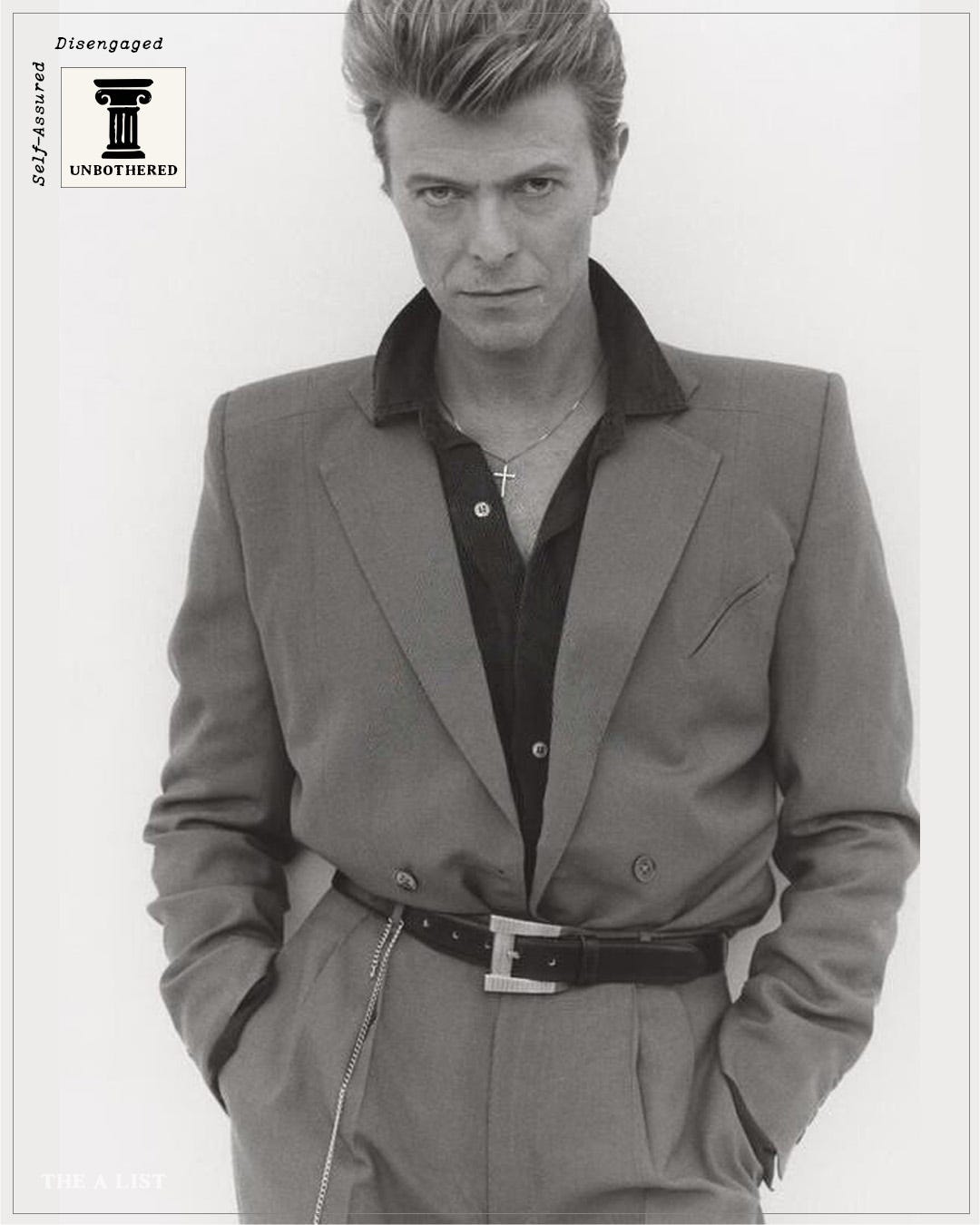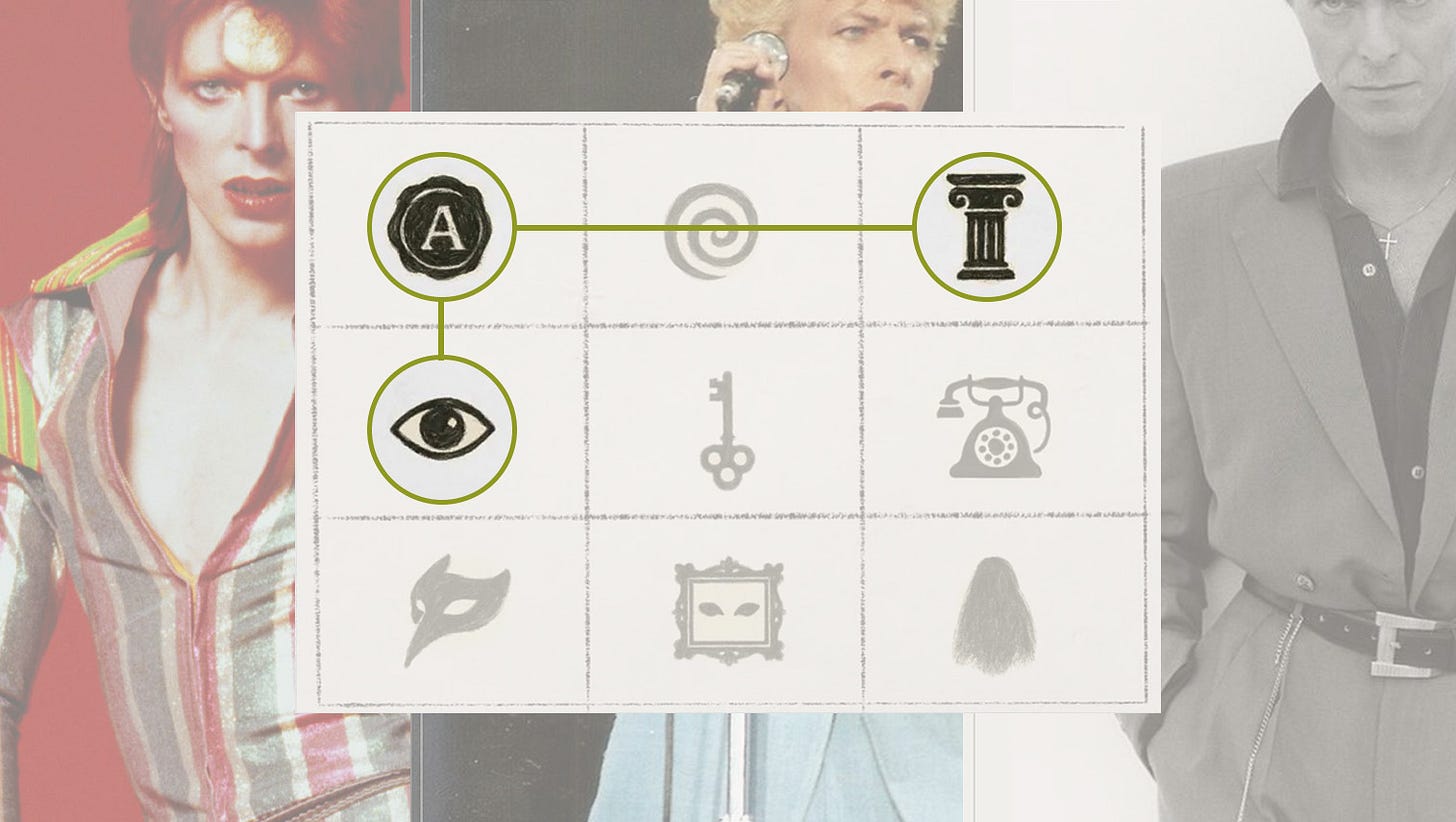David Bowie and the Evidence of Style
Mapped through The Seeker, The Signature, and The Unbothered
Style as Evidence: Case studies in aesthetic evolution and psychological alignment, interpreted through the Style Alignment Chart.
Our style isn’t our identity. Our style is how we shape our identity.
Our appearance becomes behavior, and our behavior becomes self. Therefore, style is not metaphorical. It’s behavioral.
That’s the foundation of the Style Alignment Chart: a diagnostic framework made up of nine archetypes, each showing how your internal state is expressing itself outwardly—through posture, presence, and appearance.
Where to begin, with a man like David Bowie? The truth is, there is no other man like him.
Equal parts invention, instinct and brilliance; everyone has an image that instantly conjures when his name is spoken, even those who dont know Ziggy Stardust from Charlie Brown.
For me, David Bowie has enchanted me for as long as I can remember. He is someone so captivating, so dazzling, I was shocked my parents didn’t share my near-obsession when I discovered an old vinyl of his tucked away in a long-forgotten cabinet. As a child who tore through fantasy books the way most did with legos, with the same zest as the owners of the Barbie Dream Houses, I felt spellbound. I realize I am not unique, not even a little bit, in saying this; however, even if I never heard a word of his music, I think I might have still had his poster on my wall.
Phase 1: The Seeker
(Deliberate + Neutral)
Presentation as experiment.
In the early 70s, Bowie didn’t dress to express stability. He dressed to push identity apart and see what else might exist. Ziggy Stardust came to life in 1972, metallic jumpsuits by Kansai Yamamoto, platform boots, kabuki makeup. A year later came Aladdin Sane, with the lightning bolt splitting his face and searing into our collective memory. By 1976, he discarded both for the Thin White Duke, a dramatic shift with slicked-back hair, sharp waistcoats, a cold silhouette that made his presence feel so precise, it almost made him even more larger-than-life.
He was a gender-bending shapeshifter, someone who never found comfort in repetition, toggling between extremes in search of discovering more and more about himself. His music echoed this range, traveling from loud and theatric to more soulful, even softer.
Bowie’s refusal to repeat a single look across albums is the very heartbeat of The Seeker, someone who is looking for themselves through endless reinvention. He didn’t ask “who am I?” He asked, “what happens if I become this?”
Phase 2: The Signature
(Deliberate + Self-Assured)
Presentation as authorship.
By the late 1970’s Bowie stepped into a mode of authorship, different than he had worn before. His wardrobe was defined by distinct tailoring, consistent forms of authorship expressed throughout different aesthetic treatments, a new form of personal, stylistic code. Bowie’s look became shorthand for his authority: the style was clean, intentional, and repeatable.
During his Berlin years, Bowie turned to a more stripped-down look: His wardrobe was defined by distinct tailoring, trench coats, and a cooler, seemingly more restrained image that stood in sharp contrast to the costumes that came before. The punch of Ziggy and the Duke gave way to something steadier. By 1983, during Let’s Dance, the powder-blue suit and open-neck shirts became his defining silhouette, the power of such proven by how instantly recognizable it is to this day. Across videos and press, his wardrobe stayed consistent and deliberate, built from clean lines, purposeful color choices, and sculptural hair.
Unlike the beautiful chaos of The Seeker, here we see the logic of The Signature: repetition becomes identity. His presence became legible without excess, proving that alignment is not about novelty, but about clarity.
To note: The Signature archetype is not defined by one ‘uniform’, but through ones ability to dress in different ways while always like themselves.
Phase 3: The Unbothered
(Disengaged + Self-Assured)
Presentation as ease.
In his later years, Bowie no longer dressed to experiment, his style shifted into a comfortable ease. To anyone else, the casual coats, baseball caps and simple cotton tees might signal a level of disengagement, but for Bowie, becoming The Unbothered archetype reflected an assurance so internalized it no longer needed visible proof.
In interviews, he appeared in sneakers and caps. The silence in his clothes reinforced the presence in his persona. Even in his final Blackstar appearances, monochrome tailoring revealed a man whose clarity was so complete that performance was unnecessary. The look was minimal, but the authority was absolute.
The Transformation
The Masked → The Seeker → The Signature
Deliberate + Withdrawn → Deliberate + Neutral → Deliberate + Self-Assured
Bowie’s transformation wasnt linear. He began in costume, and fractured multiple times to test multiple identities. He embodied characters no one else, including himself, knew existed. His final phase was a release of all his previous identities, while at the same time, a culmination of them. He settled comfortably into himself, into David. He no longer needed to search for anything new, as his psychological journey had come to an understanding, he had completed what he needed to do in order to explore who he was. When inquiry stabilizes, it becomes authorship. When authorship is internalized, it becomes ease.
This is the work of alignment: not finding the right outfit, but finding the version of yourself who no longer needs to be styled into existence. Who we think we are, is who we design ourselves to be. Your style is a self-fulfilling prophecy.
Bowie proved that you can change as many times as you like, while always remaining yourself.
He never mistook his style for mere decoration; he treated it as a great experiment to be wielded in the public eye; his aesthetic hypostheses wild enough that even Tesla would gasp.
He didn’t just change his look, he proved how one can become. His movement from The Signature into The Unbothered is proof that our journeys in style alignment are made powerful through our own grasp and knowledge of who we are, why we dress the way we do. There is no place on the chart better or worse, only the one that feels most like you.
The next time you get dressed, I ask that you give yourself five minutes to ponder the possibilities: Who would emerge, if I stopped asking who I was? Who do I have the power to become?
The same stardust that made Ziggy created you, too. Don’t you allow anyone else, even youself, to tell you differently.
With great personal aesthetic,
Alexandra Diana, The A List



